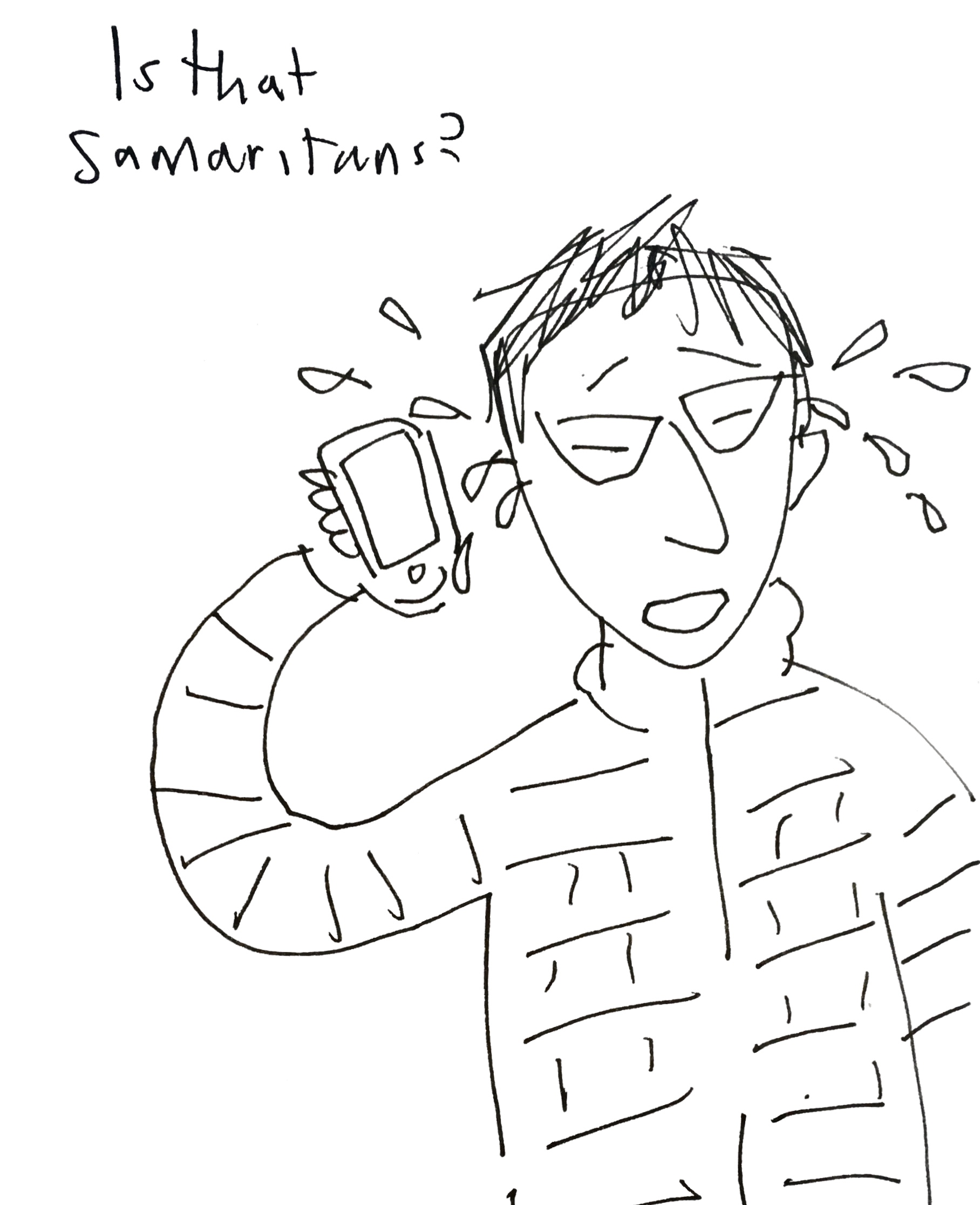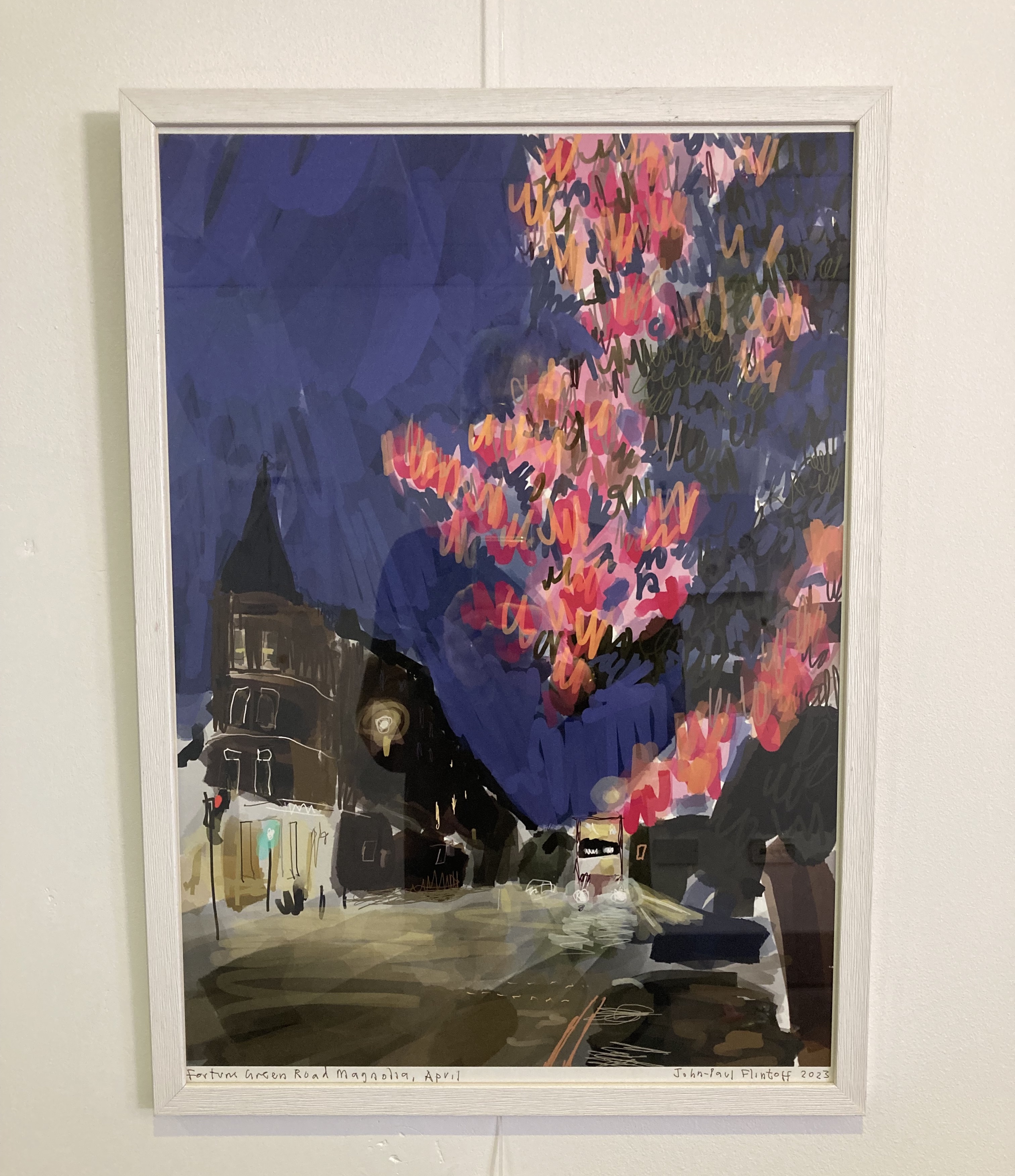I did an hour-long podcast interview with Joel Levack, proprietor of the All Is Joy gallery in Soho, where my art is currently up on the walls.
Some of the works were made when I was very fragile, and I attempted to get that across by hanging them from bulldog clips, without a frame – as you see above.
The podcast was about health.
We talked widely, but kept coming back to the healing qualities of making art, writing and performance – and how each of these can enrich the others.
In the extract from our conversation below, I attempt to describe that: I have an experience – I draw a picture of it – I tell a story about the picture – and I notice (like some kind of theatre director) aspects of body language and point of view.
First Group Therapy Session
Coming back to body language (I said to Joel in the podcast). You see this picture here? One of the things about impro that helped me a lot in my illustration is body language.
These two people, at this moment, put their hands on me. There’s something very powerful about touch: I was no longer alone. I’d burst into tears, was sobbing for what felt like an eternity, and felt very alone. Instinctively, they put – well, I don’t know if it was instinctively – but they did put their hands on me. Both of them put a hand on my knee. And I remember feeling that was that was A Good Thing. It was nice.
And as it happens, I remember the therapist fidgeting a lot. His name was Gareth.
You’ll notice that my friend’s leg is pointing towards me, which is generally a warm thing. If she was pointing away it would it would generally indicate a kind of closing away. So you can see there’s a lot of energy flowing towards me and warmth and goodwill. You can stop to think about that in an image, but it’s something we don’t necessarily think about in everyday life.
Of course, I’m saying all this as a post-rationalisation. At the time, I just drew what I remembered. It wasn’t calculated, I wasn’t thinking: I am now going to show these things. This happened, and I drew it.
But now, looking at it, I think it’s quite interesting that I drew the scene from this perspective. I could have drawn it from my own perspective, but I drew it from a window up here, as if I’m someone outside looking down through the window. And so we see her, we see the therapist, but we don’t see the young man nearest us. Why did I do that? I don’t know why. The obvious answer is that I wanted to see myself.
Impro has been a great asset – it’s taught me to think about body shapes and the arrangement of human beings in a way that feeds back into my drawings and storytelling.
***
Asking for help

For me, calling Samaritans the first time was huge, really a big hurdle. I couldn’t bring myself to call them because then I’d be – I’d be some terrible, shameful person, like, someone who’s called Samaritans.
But I did it once, and I felt much better and so it was easier to call again.
Of course, it wasn’t always because I was having the biggest crisis in whole world. But I was upset, worried and panicky. I needed someone to – someone to whom I could say out loud things I was wrestling with. So yeah, it’s good to call Samaritans if you don’t want to – but also need to.
Other images in the show
As well as the fragile works about my internal state, the show at All Is Joy includes pictures I made much later – pictures intended to celebrate the beauty in the world around me.
You may have seen this one before, though not in a frame on a wall in a gallery in Soho:

I’ve been pretty useless about telling anyone I have a show. For instance, this is the first time I’ve actually named the venue, and I haven’t given you an address. My wife and daughter don’t even know where it is.
I suppose I’m a bit shy about it. But hey. If you want to know, just ask.
And if I get the sense anybody wants to see it, I’ll make sure I’m there in person for a – well, it’s too late for an opening party, but maybe I could do one for the closing.
